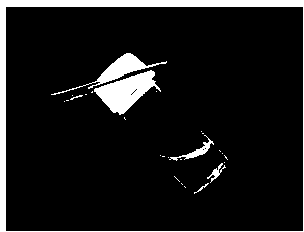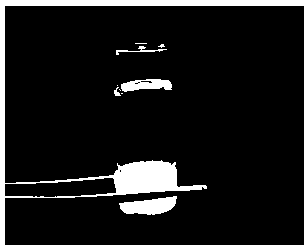Epsilon-polylysine-DOHA in-situ gel adhesive material and preparation method thereof
A polylysine, in-situ gel technology, applied in surgical adhesives, applications, medical science and other directions, can solve the problems of in-situ gel and preparation methods that have not yet been reported, and achieve good biodegradability, preparation Mild conditions and low cost effects
- Summary
- Abstract
- Description
- Claims
- Application Information
AI Technical Summary
Problems solved by technology
Method used
Image
Examples
Embodiment 1
[0024] Weigh 1 g of dextran powder with a number-average molecular weight of 100,000 and dissolve it in 80 ml of deionized water, and stir at room temperature until it is completely dissolved; weigh 790 mg of NaIO 4 The powder was dissolved in 25ml of deionized water and stirred until completely dissolved; the NaIO 4 The solution was added to the dextran solution, protected from light, and continued to stir at a stirring speed of 200 rpm for 24 h; 4395 mg of diethylene glycol was added to the mixed solution of dextran and stirred at room temperature for 1 hour; after the reaction was completed, the solution was dialyzed with deionized water as a medium for 72 hours, and lyophilized to obtain dextran aldehyde with an oxidation degree of 42%. Dissolve the dextran aldehyde sample in phosphate buffer with pH=7.2~7.4 to prepare a dextran solution with a concentration of 200mg / ml;
[0025] Weigh 1.5g of ε-polylysine powder with a number average molecular weight of 4000, dissolve it...
Embodiment 2
[0028] Weigh 2g of dextran powder with a number average molecular weight of 70,000 and dissolve it in 160ml of deionized water, stir at room temperature until completely dissolved; weigh 1.8g of NaIO 4 The powder was dissolved in 54 ml of deionized water and stirred until completely dissolved; the NaIO 4 The solution was added to the dextran solution, protected from light, and continued to stir at a stirring speed of 200 rpm for 24 h; 4 790 mg of diethylene glycol was added to the mixed solution of dextran and the mixture was stirred at room temperature for 1 hour; after the reaction was completed, the solution was dialyzed with deionized water for 72 hours, and lyophilized to obtain dextran aldehyde with an oxidation degree of 45%. Dissolve the dextran aldehyde sample in a phosphate buffer with pH=7.2~7.4 to prepare a dextran solution with a concentration of 150mg / ml;
[0029] Dissolve 1.5 g of ε-polylysine powder with a number-average molecular weight of 4000 in 65 ml of ph...
Embodiment 3
[0032] Weigh 3g of dextran powder with a number average molecular weight of 40,000 and dissolve it in 240ml of deionized water, stir at room temperature until completely dissolved; weigh 2.4g of NaIO 4 The powder was dissolved in 76 ml of deionized water and stirred until completely dissolved; the NaIO 4 The solution was added to the dextran solution, protected from light, and continued to stir at a stirring speed of 200 rpm for 24 h; 4 1.2 g of diethylene glycol was added to the mixed solution of glucan and the mixture was stirred at room temperature for 1 h; after the reaction, the solution was dialyzed with deionized water as a medium for 72 h, and lyophilized to obtain glucan aldehyde with an oxidation degree of 48%. Dissolve the dextran aldehyde sample in phosphate buffer with pH=7.2~7.4 to prepare a dextran solution with a concentration of 180mg / ml;
[0033] Dissolve 1.5 g of ε-polylysine powder with a number average molecular weight of 4000 in 60 ml of phosphate buffer...
PUM
 Login to View More
Login to View More Abstract
Description
Claims
Application Information
 Login to View More
Login to View More - Generate Ideas
- Intellectual Property
- Life Sciences
- Materials
- Tech Scout
- Unparalleled Data Quality
- Higher Quality Content
- 60% Fewer Hallucinations
Browse by: Latest US Patents, China's latest patents, Technical Efficacy Thesaurus, Application Domain, Technology Topic, Popular Technical Reports.
© 2025 PatSnap. All rights reserved.Legal|Privacy policy|Modern Slavery Act Transparency Statement|Sitemap|About US| Contact US: help@patsnap.com


